Whitebarrel Winery
by
Kathy Sullivan
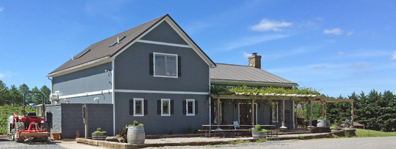 Summary: Whitebarrel Winery, located in southwest Virginia, is owned by a husband and wife team who are professional microbiologists with PhDs in microbiology. The winery produces traditional wines and fruit wines including the special Fig wine. According to Rick Obiso and Tess Gallagher, owners, “We create happiness through our wine.”
Summary: Whitebarrel Winery, located in southwest Virginia, is owned by a husband and wife team who are professional microbiologists with PhDs in microbiology. The winery produces traditional wines and fruit wines including the special Fig wine. According to Rick Obiso and Tess Gallagher, owners, “We create happiness through our wine.”
Dr. Richard Obiso known as Rik and his wife, Tess, Dr. Theresa Gallagher are the owners of Whitebarrel. Rik is the Winemaker and General Manager; Tess is the Operations and Research Manager.
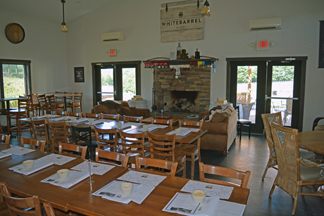 Tasting Room
Tasting Room
Arriving at the Whitebarrel facility, visitors will see a vineyard close to the winery and tasting room. Inside, the decor of the Whitebarrel tasting room is rustic with an emphasis on wine in an attempt to reflect the southwest region of Virginia and wine. The room has a long tasting counter. Opposite the tasting counter, there is a fireplace with comfortable seating. Nearby doors lead to a patio with seating and views of the vineyards. Next to the vineyard there is a horseshoe pit. What a enjoyable idea of a game of horseshoes while enjoying a glass of Whitebarrel wine! At the time of our May visit, the tasting room was set up for the Virginia Governor's Cup case tasting event.
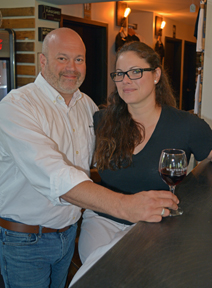 Background
Background
While talking with Rik, he mentioned that his great grandfather made wine in Sicily and his grandfather made wine in New Jersey. Rik grew up in a wine environment. He made wine as a hobby. “The hobby became an obsession.” At one time Rik believed that, “I’ll own a winery some day when I retire. Then this happened.”
As biotech experts, Rik and Tess have worked in the country Georgia and are also familiar with the Georgian ancient winemaking culture. Rik first went to Georgia in 2008. During our conversation, Tess said, “We like to visit a lot of countries. We try to bring in elements from that country to what we do here.”
Today Rik uses some of the ancient winemaking techniques in his winemaking. For example, with Chambourcin, he crushes the grapes and the skins, and places the juice, skins and seeds in a concrete tank for four months. For Vidal Blanc he ferments the juice on the skins for two weeks. He noted that for the Vidal Blanc, he pulls the grape leaves on the north side that causes the grapes to turn from green to an almost brown color. This increases the tannins.
History of the Winery
Originally, for a few months, the winery was called Eclipse Winery. This name was followed by Attimo Winery from 2009 to 2015. The winery was rebranded to Whitebarrel Winery in 2015.
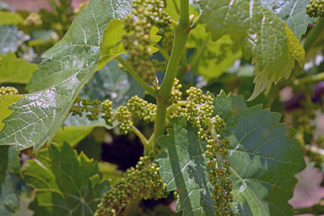 Vineyards
Vineyards
Currently Whitebarrel Winery has 15 acres of vineyards. The vineyards, with clay and shale soils are well drained. This particular area receives less rain than neighboring areas.
The vineyards are planted with Cabernet Franc, Petit Verdot, Chambourcin, Baco Noir, Saperavi, Vidal Blanc, Viognier, Petit Manseng, Chardonnay and Seyval Blanc.
The vineyards are farmed with mostly organic and biodynamic techniques. Grapes are hand harvested. In addition, Rik and Tess lease three acres of vineyards that have Cabernet Sauvignon and Merlot.
Whitebarrel is a "Virginia green" winery. The winery is able to recycle 95% of the waste. They compost vineyard and food scraps and recycle water.
Research at Whitebarrel
Since Rick and Tess are scientisits, it came as no surprise that Rik and Tess are involved in vineyard research. Currently they have two primary research areas.
The couple is investigating viruses known as bacteriophage to control bacteria that causes crown gall in grapevines. They are injecting the vines at the graft site that causes the bacteria and then injecting the virus to see if it kills the bacteria. According to Rik, Frontenac is tolerant of crown gall, while Cabernet Sauvignon is very susceptible.
The second research initiative is looking at hemp as a cover crop for vines. Currently they are working with a 2 foot tall hemp plant that will flower. It blocks out weeds and the hemp plant is anti-fungal and anti-insecticidal.
Whitebarrel Wines
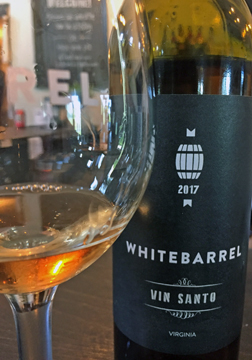 Vidal Blanc 2017 with 13.5% alcohol, was a yellow color with a slight gold hue. The aroma was floral with a hint of tropical fruit. The taste included lemon, melon, honeysuckle and a touch of pineapple The finish was crisp and fruity.
Vidal Blanc 2017 with 13.5% alcohol, was a yellow color with a slight gold hue. The aroma was floral with a hint of tropical fruit. The taste included lemon, melon, honeysuckle and a touch of pineapple The finish was crisp and fruity.
Vidal Blanc Reserve 2017 had 13.5% alcohol. The wine was fermented on the skins for two weeks. The result was a dark yellow colored wine with a gold hue. The aroma offered notes of flowers. The taste had roses, honeysuckle, daisies and citrus. The finish was crisp and floral.
Vin Santo 2017 had 16.5% alcohol. This wine was produced with the appassimento technique. The Vidal Blanc was pressed over Merlot skins. The residual sugar was 40 g/L. The wine was an amber color. The aroma had flowers. The taste had a velvety mouthfeel with roses, honeysuckle and daisies. The finish was crisp and not that sweet.
Chambourcin 2016 with 12.5% alcohol was a translucent dark red color. The aroma was of red berry fruits. The taste offered raspberry and red cherry notes. The wine was medium bodied with medium tannins. The finish was fruity.
The Petit Verdot 2017 had not yet been released at the time of our wine tasting. The wine had 13.8% alcohol.The wine was a translucent dark red color with a ruby hue. The aroma was of black fruit. The wine had a silky mouthfeel accompanied by blackberries, black caps, black plum and some leather. The full-bodied wine had bold tannins. The finish had fruit with a touch of oak.
Fig Wine is made with fruit from the Whitebarrel property. This 15.6% alcohol wine had a residual sugar of 80 g/L. The wine was a dark orange color with a red hue. The aroma was of flowers. The taste offered notes of daisies, honeysuckle, white roses and figs. The finish was delicious and not overly sweet.
Our tasting ended with the 2013 Bin #831. This 18% alcohol wine was produced with grapes from Portugal and brandy from California. The wine is a blend of Touriga Nacional and Tinta Madeira. The wine was fermented and aged at Whitebarrel for two years. During the aging raisins were added for a few months and then removed. The wine was ruby color with a sienna hue. The aroma was of dark jammy fruits. The taste had notes of black raspberries, black cherries and blueberries. The finish was very fruity with very little alcohol burn. This port-style wine is produced every other year.
When planning an itinerary include a visit to Whitebarrel Winery. Decide to stay awhile and enjoy a glass of wine next to the fireplace or on the patio.
Whitebarrel Winery
4025 Childress Rd,
Christiansburg, Virginia 24073
GPS: N37º 02.9445’ W80º 30.7850’
Article written June 2019.
Visit these Virginia wineries and wine tour groups that partner with Wine Trail Traveler.




